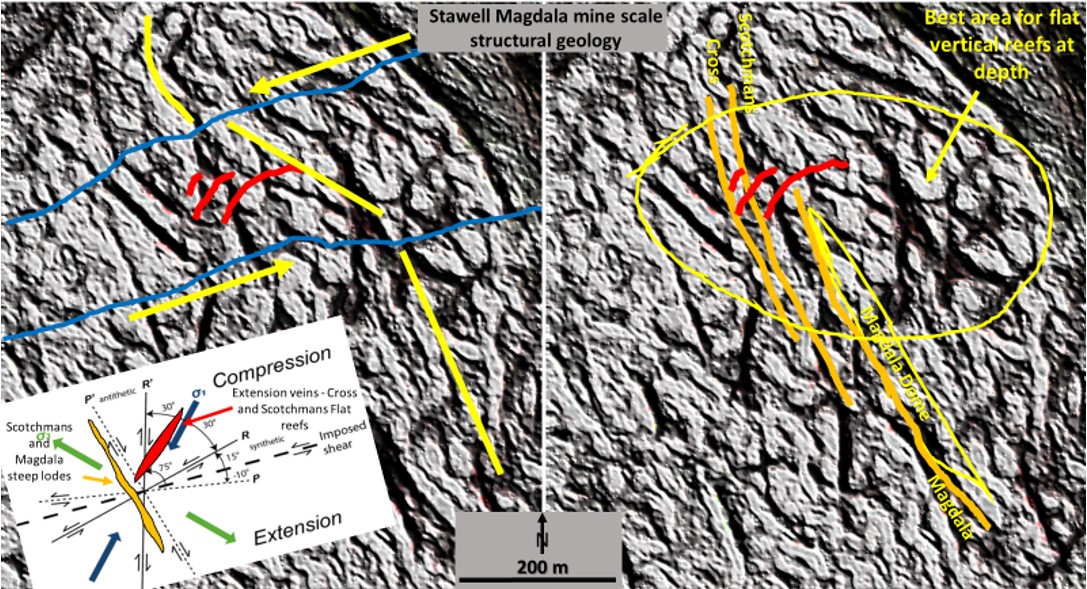9.Magdala Mine scale enhancement
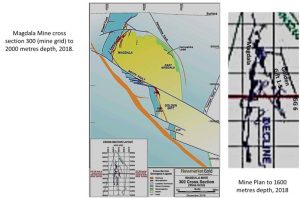
This figure shows the Magdala mine cross-section down to 2600 m below the surface.
The original, shallow Magdala mine is at the top left and the Golden Gift ore-bodies are in the centre. As we have seen on the previous images there are a lot of subsidiary faults associated with South Fault.
The mine plan of the underground stopes is shown on the right-hand side. It is interesting that the Magdala mine is at about 30° to the Golden Gift stopes. This divergence relates well with structures on the larger scale, as we will see in the following images.
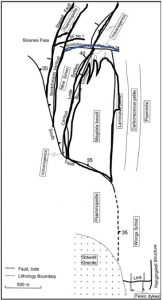
Generalised plan of the 468 level in the Magdala deposit that has been extended south to include the Wonga deposit adjacent to the Stawell Granite. The two deposits are separated by the South Fault from Mapani, B.E.S and Wilson, C.J.L 1998.
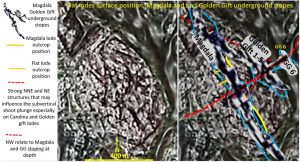
This is a cut out from the larger scale image.
Many linear structures are seen and we will see how they relate to the structures at mine scale. The right-hand image shows the faults taken from the regional image. They relate well to structures at this scale.
This figure shows the Magdala and Golden Gift stoping relationship with the structures at the mine scale. The Golden Gift ore bodies trend 30° further to the NW than the Magdala ore body.
There are strong magnetic structures on this trend, which is the South Fault trend, and are very pervasive over the region. These WNW structures are strongest at the surface straight above the Golden Gift ore bodies, maybe they are vertical?
The structures seen at the mine scale are only 10 to 20 m in thickness. They should be quite reliable for more detailed exploration targeting purposes. More work is required to get these plans up to a good exploration targeting standard.
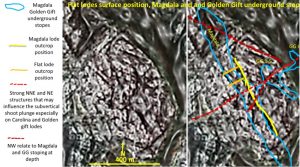
This figure is a first attempt to relate the known mine structures to the structures seen at the scale on the Magdala dome.
The yellow solid line is the surface plot of the Magdala lode and relates exactly to the dark NW structure on the image. The two orange lines are the direction of the Cross and Scotchmans Flat lodes and they relate to fainter, but pervasive ENE structures.
The red ENE line relates to the rich Golden Gift ore bodies that extend out to the east but not apparently very far north and south. Maybe this red dashed line is associated with the vertical plunge direction in the ore bodies and it follows the strike direction of the flat reefs.
We will further enlarge this image and look at the Flat Vertical reef relationship to the structural geology on the next two images.
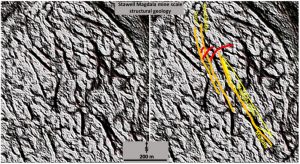
This is a cut out from the previous medium-scale image.This figure shows the Magdala and Cross and Scotchmans and Magdala orebodies’ (from figure 28) relationship with the structural geology at the mine scale. The Cross and Scotchmans flat ore bodies trend 30° E. Is there structural geology observed that gives an extensional opening in this direction? There is an ENE (80°E) trend that brackets the flat reefs that would cause extension (see next figure).
There are strong WNW magnetic structures which is the Scotchmans Fault trend and is very pervasive over the region. At the surface, these structures are strongest at either end of the lode system. They may be the shear system that controls the vertical lodes. We know from underground workings that they plunge North at 30°.
The structures seen at the mine scale are seen down to 10m in thickness. They should be quite reliable for more detailed targeting purposes. A larger cutout could be taken from these plans to enable even closer examination of the mine area – but the point has been made.
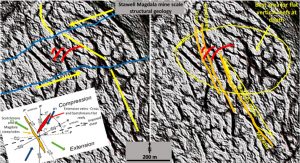
These figures show the sinistral sense of movement which caused the compressional/extensional regime that formed the Flat/Vertical orebodies (in D4-D5) as shown in the Riedel diagram. The conclusion is that the WNW, north plunging faults (South Fault type) control the main NNW lode systems The ENE regional breaks control the vertical shoots and the 400 metre wide, 80°, sinistral ‘wrench’ shear system controls the high-grade flat/vertical lode systems.
Therefore, in new fields (Wildwood etc) we need to look at areas using this structural geology knowledge as well as the right competency/geochemical contrast lithologies. The area circled on the East limb of the Magdala anticline has all the right structural geology to host good flat and vertical lodes in the right host rocks. The surface is sandstone but do the right lithologies occur at depth?
These images could be further enlarged without pixelation for a more detailed look at the individual mines’ structural geology.
Remember the original image was regional 100 x 100km regional magnetics. To get down to 1 x 1 km enlargement shows the tremendous enhancement obtainable. This is a 100 X enlargement. And it can be enlarged that much again without pixelation. I can explain how this is done to those interested.
We need to find more economic mineralisation and using my techniques around old fields is a great way to start.
If this research applies to your company and others you know SHARE IT !
The next post will conclude and tie together these paradigm changing papers on Stawell structural geology as it relates to mineralisation in the Magdala mine.
Happy hunting
Bob

